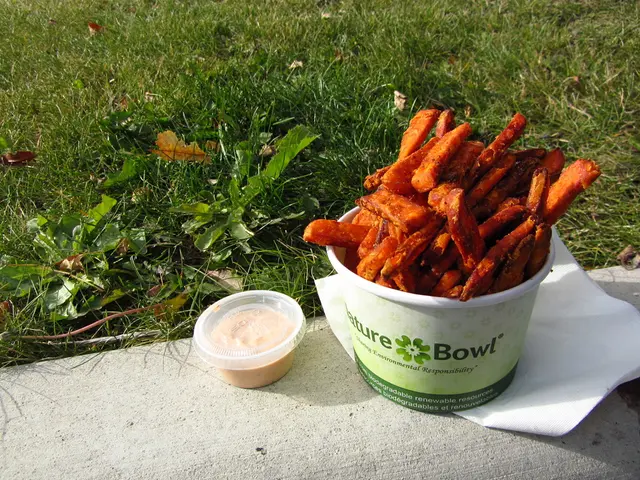Long-Term Running for Physicial Fitness: Delving into the Advantages of Diligent Running Habits
Hear the Echo of Your Own Resilience:
Step into a whirlwind of sweaty sneakers and labored breaths as the gym springs to life. Some students are racing each other, their pounding feet creating a rhythmic cadence on the polished gym floor. Most are slowly jogging, or rather shuffling, as the air thrums with exertion. The gym echoes with the collective struggle of bodies testing their limits during every class period.
Running – a veritable Superbowl for masochists, no? It's a forceful gasp for air, a surge of fatigue, and an ocean of sweat. Rather trade those moments for a serene day at the beach with an ice cream cone, under the warm sun instead of sweltering heat.
But here's the kicker – despite the discomfort, the endorphin-laced agony, running does our bodies some serious good. Lots of people are willing to suffer through the sweaty hellscape that is summer running. So, what gives?
Unraveling the Pain Paradox
Our bodies, almost fashioned for combat, are equipped with the ideal cooling system, muscles, and coordination to excel at running. Humans can outlast just about every creature in the animal kingdom on foot. It's hard to fathom given that running an untrained three miles sends most humans into a state of near-collapse. The question then arises, what makes running so arduous?
When we start running, our bodies react in a specific way to maintain homeostasis, the body's ability to self-regulate. Our muscles leap into action, creating energy in the form of ATP, so our body can move. Through aerobic respiration, the intake of oxygen helps our body produce energy for running. Oxygen fuels the reaction and produces energy for our body, but without sufficient oxygen, energy dwindles. Our muscles tire and can become sore. The muscle aches and inflammation that follows a run are due to the microtears in our muscles caused by excessive exertion. These tiny tears heal over time and, surprisingly, foster stronger muscles, driving our progress.
Additionally, our muscles generate heat, raising our body temperature. In response, our body releases sweat, trying, albeit feeblely, to cool our overheated muscles.
Running pushes the limits of both physical and mental endurance. It's easy to run for a few minutes, but what about an hour or more? Running tests not only our physical stamina but also our mental fortitude – the mental determination to...drumroll please…run in the first place.
Running: Life's Mountain Bark
Can you feel the burn in your muscles now? With regular running, they'll gradually transform, getting stronger and more defined. Remember that exhaustion after a long run? Over time, you'll be able to run longer distances at faster speeds as your endurance builds. These benefits, along with many others, remain under the surface, quietly fortifying your body from within.
Running primarily targets the cardiac muscles, the muscles surrounding the heart, and the heart itself. As our heart strengthens, it requires less energy and oxygen to pump blood effectively, leading to a lower resting heart rate. This means your heart undergoes less strain to keep blood pumping through your body, reducing the risk of heart disease and other cardiovascular complications.
Running doesn't just activate the large muscles in our body, but also works the smaller ones. Slow twitch muscle fibers, the unsung heroes of the exercise world, use energy steadily and contract slowly, allowing us to endure longer periods of exercise. These fibers contain a higher density of myoglobin, a protein that supplies our muscles with oxygen, and mitochondria, which produce energy for the cell. Running enhances our slow twitch muscle fibers, strengthening our ability to power through longer, more grueling workouts.
Getting Your First Steps Right
Transforming into a running machine may seem daunting, but it all starts with that first step. Don't try to overhaul your entire life, tackling running, a new diet, and an intensive exercise routine all at once. The biggest obstacle? Taking that first step. After a day or two, your muscles will ache, and even a ten-minute jog might leave you winded. Start with achievable goals, gradually progressing as your confidence (and stamina) skyrockets.
Finding a partner or group to run with can make the journey more enjoyable and help keep you motivated. Running solo can feel isolating and may lead you to question your ability, while sharing the struggle with others helps remind you that together, you can overcome even the most arduous challenges. Don't forget to stretch before starting your run – neglecting warm-ups can lead to injury. Also, embrace rest days – your body needs time to recover and recharge.
Prepare to ignore the numbers. Focus less on time and pace and more on the actual run. Quick race times might seem enticing, but exhaustion can quickly follow suit, shortening your runs. Maintain a pace that challenges you, but doesn't leave you gasping for air. Don't forget to celebrate the small victories; they're just as important as the final marathon.
Hydrate, Fuel, and Maintain
Don't forget to rehydrate and fuel your body before and after a run. Adequate hydration ensures your body stays cool and functions properly, while proper nutrition provides the energy needed to conquer your runs. Fueling your body with healthy carbohydrates, fats, and proteins will prepare you for the challenge ahead, aiding in muscle recovery and building.
In the immortal words of the great Usain Bolt, "I trained four years to run nine seconds, and people give up when they don't see results in two months." Persevere, embrace the challenge, and revel in the progress you'll undoubtedly make. Your body will beg you to stop, but your heart – your resilient, indomitable heart – will be screaming, "Run!"
Photography captures the essence of sweaty sneakers and labored breaths in the gym, showcasing the struggles and resilience of individuals engaged in sports. Mental health benefits from the boost in endorphins, making fitness-and-exercise a valuable tool for overall health-and-wellness. Science explains the pain paradox, demonstrating how running, despite its physical discomfort, helps build strong bodies and hearts, fueling our stamina and endurance.






